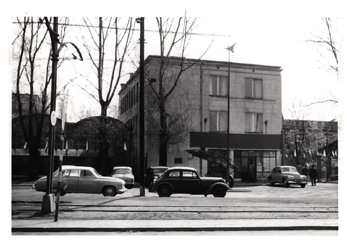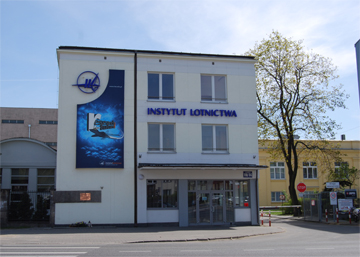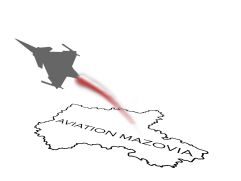Institute of Aviation in Warsaw
Although the history of the Institute of Aviation stretches back to the re-establishment of Poland’s national sovereign-ty after a First World War, officially, the Institute began its operations on 1st August 1926. From its early days until the beginning of the Second World War, the Institute operated under the title of the Institute of Aviation Technical Research and focused its activities primarily on aircraft testing and certification. Before the Second World War, all Polish military airplanes were tested and certified by the Institute. Soon it became a leading research center in Poland and a spring of innovative thought that pushed back the frontiers of the aviation industry. Rapid growth of the Institute was curtailed by the events of 1939. Although during the war the activity of the Institute was disrupted, its researchers remained closely connected with aviation finding employment at renowned research establishments abroad, particularly in the UK, and developing strategies of reactivating the Institute after the war.
In 1945 the Institute was re-established as the Technical Institute of Aviation and located in the Warsaw district of Okęcie. At this time, aeropulse and athoyd engines were being developed at the Institute and works on the breakthrough design of the SP-GIL helicopter began. The Institute was also engaged in homologation tests of the Szpak 2 aircraft and of the first afterwar glider Sęp.
In 1948 the Institute was renamed as the General Institute of Aviation, while in 1952 it was given the title of the Institute of Aviation, used until today.
In the years after the war, the Institute primarily focused on designing and producing licensed PO-2 biplanes on jet of fighters Mig-15. The main constructor at this time was professor Tadeusz Sołtyk, who supervised work on the aircraft TS-Bies and TS-Iskra, as well as the prototype of the supersonic striker and military jet trainer TS-Grot. These accomplishments still draw admiration from aviation experts.
Together with aircraft airframe construct-ions, the Institute started specializing in design and construction of projectiles, such as rockets and flying targets. One of the most successful designs was the meteorological rocket Meteor 1, developed entirely in the Institute of Aviation. Subsequent years saw the Institute focus on the programme for developing a military jet trainer aircraft for the Polish Air Force. The Iryda I-22 aircraft was granted all required certification confirming accordance of the aircraft construction programme with legal regulations and military requirements. Thus, the Institute of Aviation successfully completed the task it was entrusted with by the Polish Government.


Another challenge for the engineers of the Institute was the construction of the I-23 Manager, a 4-seater composite personal plane of the newest generation. The works were successfully completed and the aircraft’s design met with favorable evaluation from aviation experts. Developments during the period 1990-2000 which are worth mentioning include: the 2-seater trainer aircraft I-25 As, the 2-seater training & patrol helicopter IS-2, the patrol and rescue hovercraft PRP-560 Ranger.
Today, the Institute of Aviation is a research center providing high quality testing services, which offer new solutions to contemporary aviation. The Institute cooperates closely with leading companies on the aviation market, including General Electric, Boeing, Airbus and Pratt & Whitney. The Institute also provides services for other industries.
Mission and strategy
Our mission is to provide research services of the highest quality to companies worldwide.
The Institute of Aviation consists of four departments:
- Materials & Structures Research Centre
- New Technologies Centre
- Net Institute
- Engineering Design Centre.
We are determined to achieve our strategic objectives of:
- becoming a world leading research center
- increasing our competitiveness in the global research market.
Our strategy is based on both stimulating and achieving active participation in diverse international scientific priorities. The Institute of Aviation continues and expands its research into all aspects of the aviation sector.
We promote and implement research results and conduct educational activity through cooperation with institutions and organiz-ations worldwide. We invest in the development of a scientific research workforce and infrastructure. We aim at enhancing human space and organizational potential.
The Institute of Aviation executes a strategy towards a knowledge based society and economy.
On March 19 2013, Adam Struzik Marshal by Mazowieckie Province and Director of the Institute of Aviation, professor . assoc. eng. Witold Antoni Wiśniowski signed at the Office of the Marshal of the Mazovia, precontract EU funding for Innovative Technology Center of Air and Space, a project of the Institute of Aviation in Warsaw under the Regional Operational Mazowiecki Programme 2007-2013.
The Centre for Innovative Technologies Air and Space in Warsaw has the chance to become a place where not only technological ideas will be developed, but will also employ young researchers . In view of the importance of the project designed was by the Board of Mazowieckie Province entered on the list of so-called key projects , the investment extremely important for the development of the region and the country.
The new center in the next few years is willing to create a workplace for approximately 720 scientists – specialists , physicists, chemists, etc. It is extremely important at a time when talented people are often prevented from using their potential and can hardly find themselves in the labor market . It will also be a great place to visit for students and trainees – only in the last year ILOT hosted 200 interns .
Centre for Innovative Technologies of Air and Space will be in -built facility for this project – a complex of four buildings arranged in the shape of the letter H. The three of them will be first of all laboratories . The last of the buildings – the classrooms – will act as a meeting room. The total area will amount to almost 11 000 m2. The new facility will include space teams working on design and development such as stratospheric aircraft , dealing with intelligent materials and increase aircraft safety .
Importantly, innovative technologies will be developed , implemented for the first time in the country (eg, the use of various rocket motors ) . This will allow you to develop niche lines such as smart metallic and composite materials , the use of which is not limited to aerospace work . They can be used in the future, including in industry , security and safety in the construction industry , medical engineering , but also as a technology used in the creation of everyday objects.

